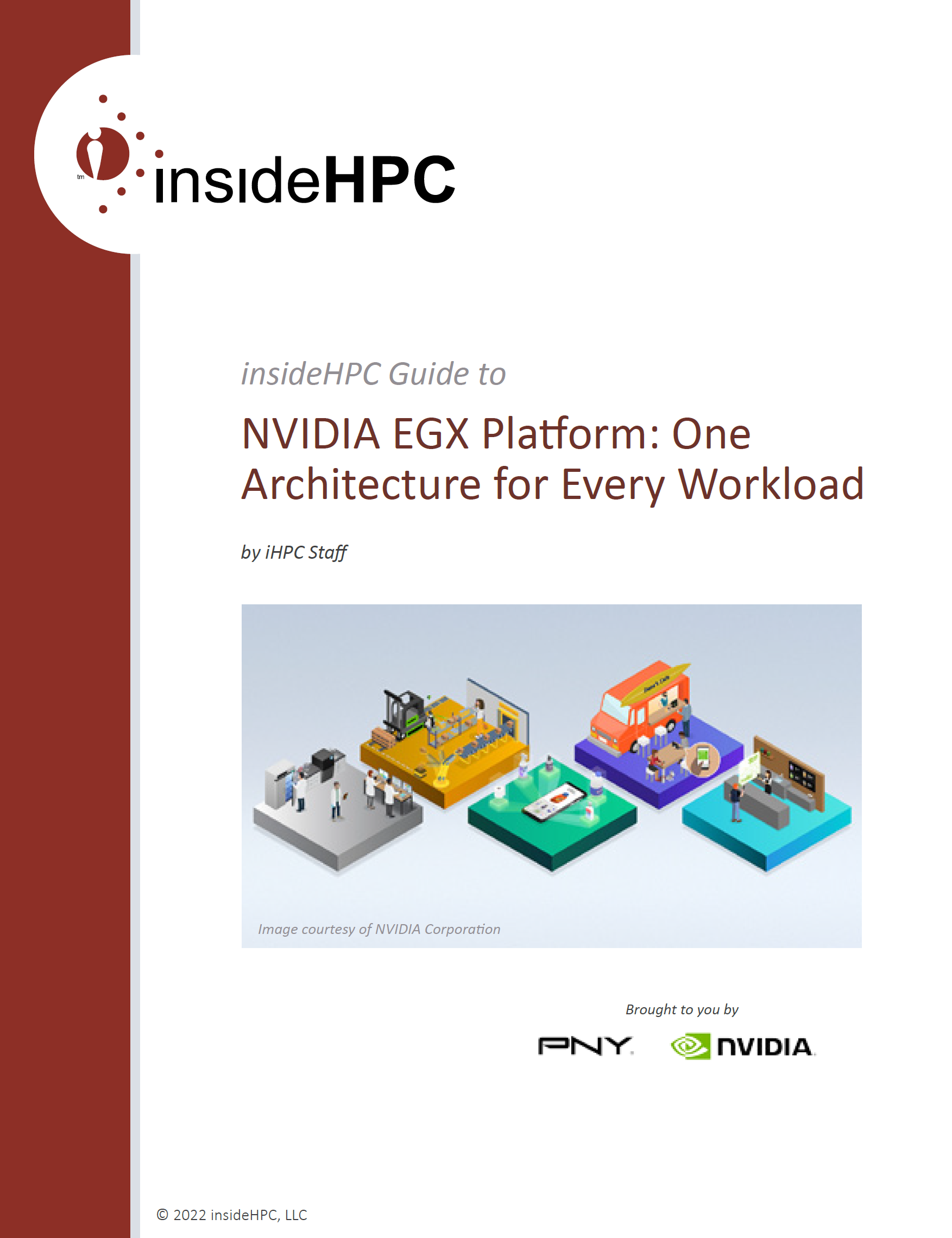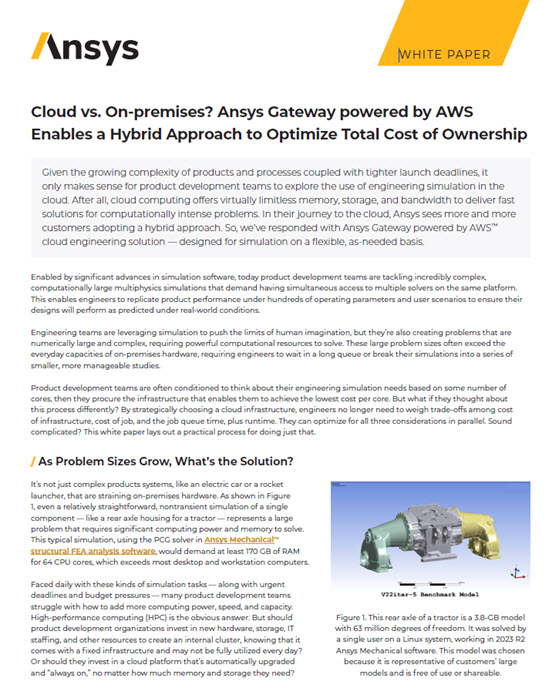Sponsored Post
 Introduction
Introduction
The massive growth of data requires that organizations analyze their data center infrastructure to meet changing workload needs. Artificial Intelligence (AI), High Performance Computing (HPC), big data analytics and professional visualization are growth drivers which are changing workloads. AI is foundational and is transforming the way businesses work across many industries. But the use of AI will become critical as new tools and technologies such as 5G wireless hyperconnectivity, edge computing, and Radio Area Networks (RANs) become a reality. According to Carl Flygare, NVIDIA Pro GPU Product Marketing Manager, PNY Technologies, “Organizations need to reimagine data centers to meet AI and big data analytics intensive workload needs, sophisticated visualization and rendering workflows, and prepare for a GPU accelerated VDI enabled mobile workforce.”
This technology guide, “insideHPC Guide to NVIDIA EGX Platform: One Architecture for Every Workload,” sponsored by PNY describes how the NVIDIA® EGX™ Platform provides a single architecture to meet every data center workload need. PNY aids in GPU selection and testing allowing partners to equip customers with the best NVIDIA EGX Platform solution based on their needs.
Massive Growth in Data Volume
Visual computing market opportunities are being fueled by technological and macroeconomic trends with continued massive growth expected as reported in the PNY GTC 2021 “NVIDIA Solutions for Essential Markets” session. In terms of rendering, there are over 6 Billion hours of rendering done per year. Over 30,000 new products are launched each year. Approximately, 67% of large U.S. architectural firms use virtual reality to interact with their designs as well as make ergonomic decisions. Global construction is slated to grow by 12.9 Trillion USD and global Computer Aided Engineering (CAE) is estimated to grow between $268 to $13,458 Billion USD by 2022. In addition, the COVID-19 global pandemic has forced many employees to work remotely. Estimates indicate that 48% of employees will still continue to work remotely either part or full-time after the pandemic abates. Visual computing platforms powered by NVIDIA data center GPUs and networking products can help make this possible provisioning data centers to make on-boarding and off-boarding of virtual work-forces easier, while enhancing productivity and lowering costs.
Data Center Workload Challenges
Many data centers have legacy systems relying on Central Processing Units (CPUs). Due to their essentially serial nature, CPUs exhibit slower performance when processing HPC software, AI models (training and inference), big data analytics or professional visualization tasks such as rendering. “Companies using GPUs have a decisive and insurmountable performance advantage. Organizations that use CPUs for functions such as professional visualization or AI cannot compete with those using GPUs,” indicates Flygare. For example, in Architecture, Engineering and Construction (AEC), CPU processing takes days for ray traced photo-realistic rendering of a building versus 15 or 20 minutes, subject to scene or scene complexity, on an NVIDIA Graphics Processing Unit (GPU).
How the NVIDIA EGX Platform Solutions and AI Meet Workload Challenges
NVIDIA GPUs and the NVIDIA EGX Platform provide an unmatched visual computing solution with performance, scalability, and power consumption benefits compared to CPUs. NVIDIA vGPU solutions scale from professional laptops and desktop workstations to other non-PC devices such as tablets. As shown in Figure 1, NVIDIA GPUs are used in many industries such as architecture, AI and data science, Computer Aided Design (CAD) and CAE, media and Entertainment (CGI and VFX), energy, healthcare, product design as well as scientific and technical research.
The NVIDIA EGX Platform provides scalable accelerated computing infrastructure for every workload —whether working on data center AI, edge AI, big data analytics, data science simulations or professional visualization in a variety of contexts. With its end-to-end performance, management, and software-defined infrastructure, NVIDIA EGX Platform uses include:
- AI Training and Inference: Run Deep Learning (DL) and Machine Learning (ML) tools to quickly train and validate AI-based applications or services.
- Data Science: Run AI simulations on exabytes of data and turn it into insights leading to new products, programs, or services.
- Big Data Analytics: Analyze data using AI to find actionable intelligence within the data.
- Rendering: Accelerate final frame rendering through either bare metal or virtual workstation instances to render scenes in a fraction of the time required by any CPU.
- Virtual Sets and Sophisticated Visual Effects (VFX): Create photo-realistic graphics and visual effects using ray tracing and physically accurate materials and simulation (physics) for work done on movies or television production as VFX houses and producers move to new ways of doing work.
- Virtualized Professional Imaging: Produce cinematic quality 3D images, animation, simulations, or video faster and within budget, with virtual workstations accessible from anywhere.
- CAD: Compress design cycles and reduce unit costs using NVIDIA RTX Virtual Workstations with performance indistinguishable from physical workstations.
- CAE: Create interactive simulations with programs such as ANSYS Discovery that offer real-time FP32 CAE or specialized software requiring hardware double precision FP64. Bringing CAE simulation earlier into the design process improves quality and avoids bottlenecks later in the design from undiscovered issues.
- Augmented Reality (AR), Virtual Reality (VR), and CAVE: Accelerate time-to-visualization with a fullstack solution that allows running AR/VR or CAVE simulations applications with the highest possible visual fidelity.
- Remote Collaboration: Using NVIDIA vGPU software such as vApps, vPC, vWS, or NVIDIA Omniverse Enterprise, globally dispersed or work-from-home teams can share design information and fluidly collaborate to incorporate evolving design iterations. The ability to work remotely from home has been critical during the COVID pandemic and remote work will continue as part of a dramatic change in working habits.
Over the next few weeks we’ll explore these topics:
- Introduction, Data Center Workload Challenges, How the NVIDIA EGX Platform Solutions and AI Meet Workload Challenges
- NVIDIA EGX Platform Hardware Meets Multiple Workload Needs, NVIDIA EGX Platform Hardware Customized for Data Center or Visualization
- NVIDIA Software Meets Customer Needs, PNY’s Role in the NVIDIA EGX Platform Ecosystem, NVIDIA EGX Platform Power, Performance, and Cost Benefits, Lost in Space Example, Summary
Download the complete insideHPC Guide to NVIDIA EGX Platform: One Architecture for Every Workload courtesy of PNY.



